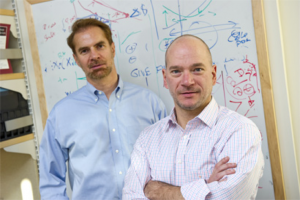Erik Brynjolfsson, Schussel Family Professor of Management and director of the MIT Initiative on the Digital Economy, and Andrew McAfee, principle research scientist at the MIT Center for Digital Business, urge us to move beyond questions of what technology will do to us and instead ask: What do we want to do with technology? What matters more than ever before, they say, is thinking deeply about what we want the future to be. Having more choices means that our values are more important than ever.
 In their celebrated 2017 book Machine, Platform, Crowd: Harnessing Our Digital Future, the duo firmly expresses optimism about the future benefits of artificial intelligence for the way we live. Not because that outcome is predestined, but because the technology at our disposal is more powerful than ever before. “Fundamentally, we have more freedom to do things that simply could not have been done by earlier generations. Rather than being locked into any one future, we have a greater ability to shape the future,” they say.
In their celebrated 2017 book Machine, Platform, Crowd: Harnessing Our Digital Future, the duo firmly expresses optimism about the future benefits of artificial intelligence for the way we live. Not because that outcome is predestined, but because the technology at our disposal is more powerful than ever before. “Fundamentally, we have more freedom to do things that simply could not have been done by earlier generations. Rather than being locked into any one future, we have a greater ability to shape the future,” they say.
The AI in our lives
McAfee and Brynjolfsson take particular interest in the growth of virtualization and its long-term implications for how we live. Virtualization—as distinct from full automation—refers to processes in which digital technologies play leading roles but do not completely exclude people. Automated teller machines (ATMs) and self-checkout retail kiosks are examples of virtualized processes that many of us interact with routinely.
 “Virtualization accelerates when networks and convenient digital devices are almost everywhere,” say McAfee and Brynjolfsson. The success of virtualized banking, for example, is made clear by the fact that the total number of bank tellers in the U.S. has decreased by almost 20% since its peak in 2007. And despite the so far underwhelming performance of self-checkout technologies, McAfee and Brynjolfsson predict large-scale adoption in the future. “When it does come, it might look like Amazon Go, an 1,800-square-foot convenience store…with neither cashiers nor self-checkout kiosks.” The store’s environment integrates cameras, sensors, machine-learning technologies, and a smartphone app to track and bill for whatever customers carry out of the store.
“Virtualization accelerates when networks and convenient digital devices are almost everywhere,” say McAfee and Brynjolfsson. The success of virtualized banking, for example, is made clear by the fact that the total number of bank tellers in the U.S. has decreased by almost 20% since its peak in 2007. And despite the so far underwhelming performance of self-checkout technologies, McAfee and Brynjolfsson predict large-scale adoption in the future. “When it does come, it might look like Amazon Go, an 1,800-square-foot convenience store…with neither cashiers nor self-checkout kiosks.” The store’s environment integrates cameras, sensors, machine-learning technologies, and a smartphone app to track and bill for whatever customers carry out of the store.
Eatsa, the virtualized restaurant concept launched in San Francisco in 2015, and Wealthfront, an AI-driven wealth management company founded in 2011, demonstrate other areas in which automation may change the way many of us conduct our lives. And while Eatsa hasn’t fulfilled expectations quite yet, Wealthfront has attracted more than $3 billion from 35,000+ households since 2011 using a platform of robo-advisers and online forms in place of brick-and-mortar locations and human professionals.
Although McAfee and Brynjolfsson acknowledge that self-selection by patrons and clients has been a key driver for these companies, they also assert that experimentation, iteration, and technical progress will expand automated and digitally mediated processes beyond the market of younger, more tech-savvy consumers. “We believe, in short, that virtualization is a secular trend, where ‘secular’ is used in the way the finance industry uses it: to denote a long-term development that will unfold over several years.”
Stay tuned, McAfee and Brynjolfsson tell us. Life in an AI world is about to get more interesting—and very probably better.
The post What do we [really] want from technology? appeared first on Leadership Blog.